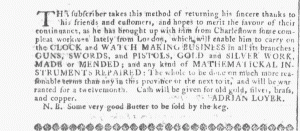GUEST CURATOR: Evan Sutherland
What was advertised in a colonial American newspaper 250 years ago today?

“The CLOCK and WATCH MAKING BUSINESS in all its branches.”
Adrian Loyer announced that he “carr[ied] on the CLOCK and WATCH MAKING BUSINESS in all its branches.” However, watchmaking was not as common as making clocks in colonial America, despite some colonists from England with the necessary skills and tools. Many colonists with watchmaking skills usually repaired watches, rather than creating them. Many of the watches used in colonial America were imported from England instead.
Clockmaking was much more common during the eighteenth century. Clocks were typically made of brass for the dial and wood for the case, including oak, walnut, and mahogany. Some clocks were made with expensive satinwood for inlays. Tall-case clocks made during the eighteenth century were typically expensive; their owners were usually wealthy. As a result, tall-case clocks were usually handed down through generations.
Individual clockmakers typically did not produce more than an average of four to five clocks per year. This was most likely due to the expensiveness of the materials required to produce clocks. Large clocks with tall cases required more materials and more time to produce. Despite these drawbacks, some clockmakers still managed to make a decent living.
**********
ADDITIONAL COMMENTARY: Carl Robert Keyes
Adrian Loyer seemed to be expanding the business he operated in Savannah, thanks to the assistance of “some compleat workmen lately from London” that he recruited on a recent trip to Charleston in neighboring South Carolina. As Evan indicates, Loyer was set “to carry on the CLOCK and WATCH MAKING BUSINESS in all its branches” at his shop, but he offered a variety of other services as well. He and his assistants also repaired mathematical instruments and performed metalwork on weapons and other items.
Residents of Savannah were apparently familiar with Loyer’s work and his reputation: he opened his advertisement by acknowledging “his friends and customers.” Former and potential customers, however, did not know much about Loyer’s new assistants and their work beyond the brief description that appeared in the advertisement. Accordingly, Loyer offered assurances to anyone who visited his shop. He pledged that any work contracted and completed in his shop “will be warranted for a twelvemonth.” In other words, Loyer offered a guarantee that lasted for a year.
Loyer did not provide further details about how his guarantee worked. Was it a money back guarantee? Or did he not charge to repair items that failed within the specified period? Or did he offer customers a choice? Edward Spauldin, who “carries on the Business of cleaning and repairing CLOCKS AND WATCHES” in Providence, explained how his guarantee worked in an advertisement published the previous summer. “If any of his Work fails,” Spauldin stated, “he will repair the same gratis.”
Loyer seemed quite conscious that potential patrons might choose his competitors in Savannah or even send their work to workshops in Charleston. That being the case, it seems most likely that he followed Spauldin’s example and made repairs for free. Doing so gave him the opportunity to satisfy customers rather than relinquish them to other clockmakers and smiths. Whatever the mechanisms of the guarantee, Loyer underscored that he took responsibility for any work that left his shop, whether undertaken by himself or by any of the “compleat workmen” he now employed.
